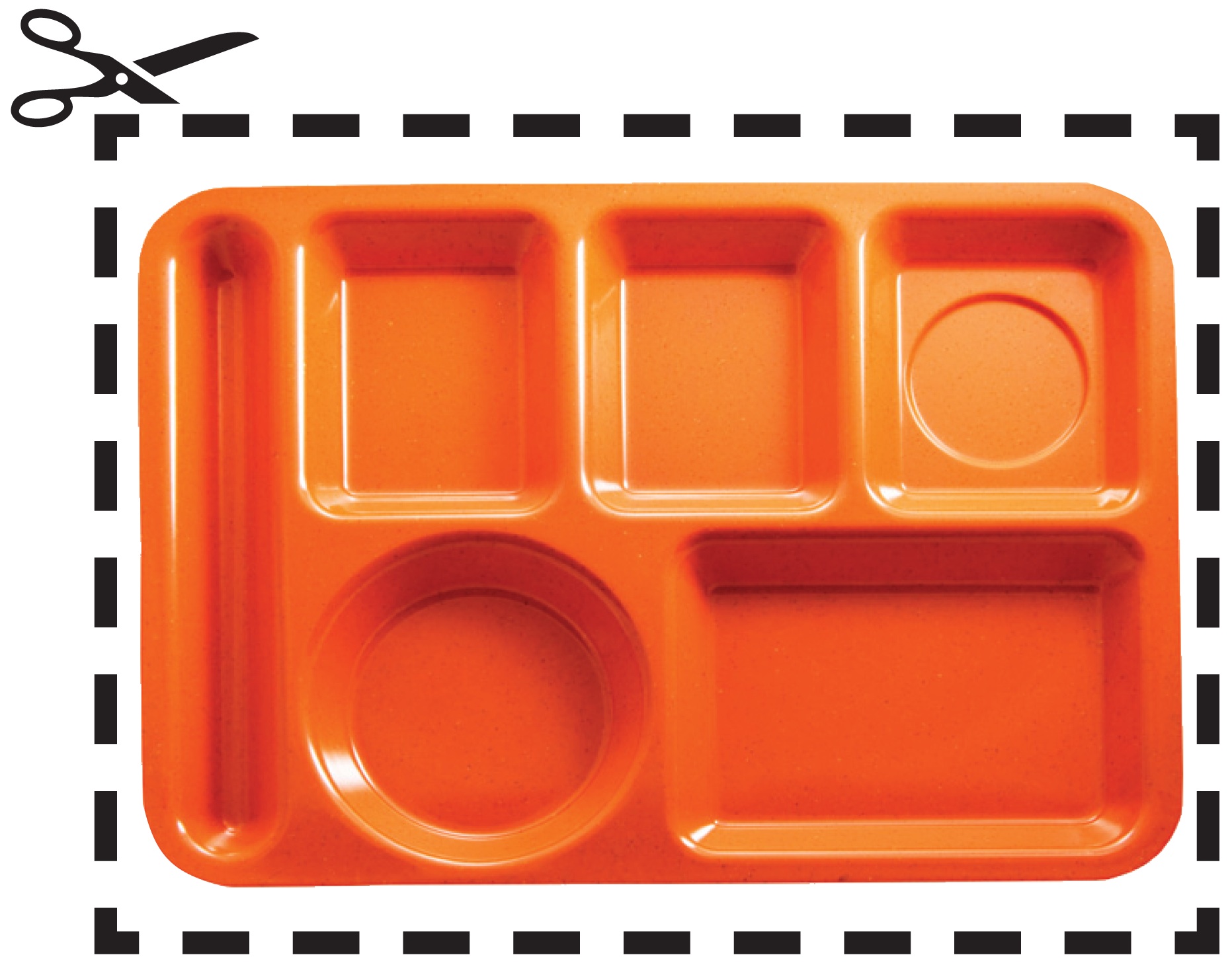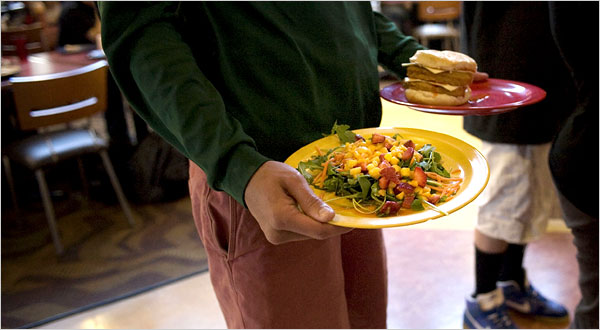 In one fell swoop, we are going to
In one fell swoop, we are going to
– conserve water
– reduce food waste
– save energy
– save money, AND
– combat obesity
Wow! That’s five in one! How? Trayless dining is sweeping the college residence halls of America.
The cafeteria tray, chock to the rim with edibles on an all-you-can-eat meal plan, may be headed the way of the dinosaur. “The Sustainable Endowments Institute, a research organization that tracks environmental practices at the 300 colleges and universities with the largest endowments, said that 126 of them had curtailed use of trays.” (The New York Times, April 30, 2009, p. A1.)
One school estimated it saved 14,000 gallons of water not having to wash an estimated 147,000 trays. Another college estimated it saved 10% on food costs in spite of rising prices. Since people can only get what they can carry on two plates and most of us practice a “seefood” diet——we eat what we see, finish off what is in front of us——rumor has it that students are eating less and losing weight, or at least gaining less.
Trayless dining is an example of “nudging” (see blog post and the book, “Nudge” ), whereby relatively small changes in environment or context can create meaningful behavioral changes that significantly can add up over time.
In our search for quick solutions, for dramatic actions, for next quarter results, for headline impact, we often eschew the simple, small changes. Yet often it is the smaller, simpler things, their effects compounded mightily over time, that can have the greatest long-term impact.
Closing Quotes:
“Small events and choices determine the direction of our lives just as small helms determine the directions of great ships.” – M. Russell Ballard
“It has long been an axiom of mine that the little things are infinitely the most important.” – Sir Arthur Conan Doyle, author
“…by small and simple things are great things brought to pass.” – Alma the Younger, Alma 37:6 (Book of Mormon)
“It is not the straining for great things that is most effective; it is the doing of the little things, the common duties, a little better and better.” – Elizabeth Stuart Phelps (1844-1911), American author/activist
—New York Times Article—

Without Cafeteria Trays, Colleges Find Savings
Oscar Durand for The New York Times
Evan Pasha, 21, carries his lunch in a Skidmore College cafeteria that underwent a $10 million overhaul, including going trayless.
By LISA W. FODERARO
The New York Times
April 30, 2009
SARATOGA SPRINGS, N.Y. — John Belushi memorialized them in “Animal House” as he stockpiled edible projectiles for an epic food fight. Generations of college students in the Northeast have deployed them as makeshift sleds. But the once-ubiquitous cafeteria tray, with so many glasses of soda, juice and milk lined up across the top, could soon join the typewriter as a campus relic.
Scores of colleges and universities across the country are shelving the trays in hopes of conserving water, cutting food waste, softening the ambience and saving money. Some even believe trayless cafeterias could help avoid the dreaded “freshman 15” — the number of pounds supposedly gained in the first year on campus (and on all-you-can-eat meal plans). “I like not having to carry a tray around,” said Peter McInerney, a freshman here at Skidmore College, as he grabbed a midafternoon snack of an egg sandwich, pancakes and apple juice. “It makes it feel like this is less of a machine just spitting food out. It’s still not home, but it feels more homey without the tray.”
The Sustainable Endowments Institute, a research organization that tracks environmental practices at the 300 colleges and universities with the largest endowments, said that 126 of them had curtailed use of trays, some of them banishing trays only from certain dining halls, and some introducing, for example, “trayless Tuesdays.” Such moves are often part of a larger push to embrace environmentalism that includes hiring sustainability coordinators, introducing solar panels, composting dining-hall waste and encouraging students to turn off lights with catchy sayings like “Do It in the Dark.”
“The trend has definitely taken off,” said Mark Orlowski, executive director of the institute, which this fall plans to add a question about trayless cafeterias to an annual survey that includes other dining-related topics like vegan entrees, biodegradable containers and community gardens. “It reduces not just waste, but energy and water consumption. Over all, it’s been very successful.”
Joseph H. Spina, executive director of the National Association of College and University Food Services, described trayless dining as “sort of the hot thing right now.”
“There was a smattering of it 18 months ago,” he said, “but every week I’m picking up another campus or two that’s adopting it,”
At Williams College in western Massachusetts, the Zilkha Center for Environmental Initiatives estimates that the college is saving 14,000 gallons of water annually since eliminating trays last spring at Driscoll, one of four campus dining halls, where 147,000 trays had been washed a year. The other dining halls are scheduled to go trayless in the fall.
At the Rochester Institute of Technology, which stopped using trays last summer, the manager of the Grace Watson Dining Hall, one of five on campus, said she had seen a marked drop in food waste, estimating that the school saved 10 percent on food spending despite rising ingredient costs.
“With the trays, you come in and often your eyes are bigger than your stomach,” said the manager, Janet Olivieri, who frequently eats at the dining hall and has lost 10 pounds since the change. “This way they can only get what they can carry on one plate. If the customer wants more, they have to make a conscious decision to come back for it.”
At Cornell University, where 5 of the 10 dining halls have done away with trays since September, the biggest pushback has come from faculty. “They were more boisterous than anyone,” said Gail T. Finan, the university’s director of dining and retail services. “A couple of professors sent me e-mails saying, ‘This is ridiculous.’ ” Skidmore, a pioneer in trayless dining, tried to minimize the jolt by implementing the change between the spring and fall semesters in 2006, when the cafeteria, the Murray-Aikins Dining Hall, underwent a $10 million overhaul.
For the most part, when students returned in the fall, they were so dazzled by the transformation of the cafeteria that they hardly noticed the missing trays. The renovated dining hall has three slate fireplaces and a half-dozen food stations, including a do-it-yourself griddle for eggs. Three of the chefs are graduates of the Culinary Institute of America, and all the pasta, granola and baked goods are made on site.
Officials said their decision to go trayless was mainly about atmosphere, though they welcomed any ecological benefit. “In our thinking, the trays were institutional, along with the conveyor belts, and we really wanted to move away from that,” said Christine Kaczmarek, director of business services at Skidmore.
But while the environmental benefits are real, going trayless is not a panacea. At Skidmore, the all-you-can-eat format and multiple food stations, featuring vegetarian, Italian and classic comfort foods, encourage students to forage, taking a bit of this and a little of that. But this system also leads to congestion as diners return to the lines for seconds (or fourths).
“That’s one of the disadvantages,” said Sam Pope, a junior from Worcester, Mass., referring to an absence of trays. “You have to keep getting up and getting more food. It increases dining hall time because there’s so much traffic.”
As part of her senior honors thesis, Sarah Whateley, an environmental studies major, conducted a research project to demonstrate how much food was still wasted in the dining hall. She asked students to scrape their leftovers into plastic bins over two days, yielding 330 pounds of food on a Sunday and 403 pounds on a Monday. The food services staff then illustrated that quantity by stacking the equivalent weight in boxes of rice in the entrance of the dining hall.
“People were really surprised,” she said. “Entire sandwiches were being thrown out, and a whole slice of pizza.”
Still, Miss Whateley believes there is less waste without the trays. “Most people don’t want to get up to get more food,” she said. “The only thing that changes is that you take less and you actually eat what you want rather than what you see.”
Dr. Spina, of the college food service association, cited another benefit: “preparation for the cocktail-party circuit” by having to balance dishware and cutlery. “You eventually have to learn how to hold your hors d’oeuvre and cocktail in one hand while making animated conversation with the other,” he said, “so it’s a life lesson.”
No word yet on what students are doing for makeshift sleds.


0 Comments